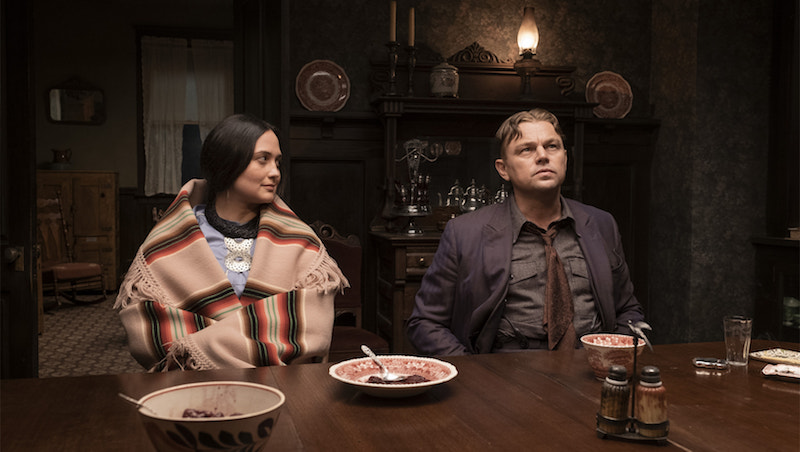Martin Scorsese’s “Killers of the Flower Moon” is Shakespearean in its depth and scope, and in its tragedy.
Set in 1920s Oklahoma, the film presents an epic true story about greed, betrayal, hypocrisy, racism, misogyny and so much more. Though not perfect, it’s clearly the work of a master, and that master is director Scorsese.
Brilliance abounds in “Flower Moon” (R, 206 minutes, in theaters), whether it’s Robbie Robertson’s soundtrack, which builds suspense with a kind of tell-tale heartbeat; the astonishing shift in setting and tone to wrap up the story; or, in what might turn out to be the cinematic highlight of the year, a performance for the ages from Lily Gladstone.
Based on David Grann’s nonfiction bestseller “Killers of the Flower Moon: The Osage Murders and the Birth of the FBI,” Scorsese’s adaptation barely touches on the birth of the FBI while keeping its focus on the murders.

Lily Gladstone and Leonardo DiCaprio appear in a scene from Martin Scorsese’s “Killers of the Flower Moon.” (Apple)
Early in the film we get a brief history lesson. The Native American people of the Osage Nation are pretty much forced to settle in a seemingly worthless section of Oklahoma. They strike oil, and suddenly they are among the wealthiest people, per capita, in the world.
Since the riches are kept within families, white men see an opportunity: If they marry into these families, they can scheme their way into not only getting a piece of the action, but all of it. All it takes is a little murder. Suddenly, there are a series of suspicious deaths among the Osage – deaths that initially go uninvestigated.
World War I vet Ernest Burkhart (Leonardo DiCaprio) becomes involved in such a scheme. He arrives by train and immediately comes under the wing of his uncle, William Hale (Robert De Niro), cattle rancher, big-shot local politician and self-described friend of the Osage people. Hale sits his nephew down and questions him about everything from his literacy to his sexual preferences. It seems like a job interview of the most personal kind; in a way, it is.
Ernest becomes a livery driver, and, at his uncle’s urging, marries one of his wealthy customers, Mollie (Gladstone). Mollie has a mother, three sisters and two brothers-in-law who all have, or potentially will inherit, the family’s wealth. Hale ruthlessly maniputes dim-witted Ernest to make the most of the situation.
What ensues is a microcosm for the deadly practices going on throughout the community – and what makes this particularly horrific is that it’s all based on real events. (I’m embarrassed to say that, before seeing this movie, I hadn’t known of this story. But, like the Tulsa race massacre of 1921, which is referenced in “Flower Moon,” it probably hasn’t gotten much attention in history textbooks over the years.)
Shining a light on the uglier side of America’s past is important, of course, though we know there are certain segments of our society that think we should turn a blind eye to it. That alone gives the film some merit; Scorsese’s artistry gives it much more.
The weak link, at times, is DiCaprio in the central role. It must be tough to play a dunce – which Ernest is – intelligently, and maybe that’s why the actor emotes to such extremes when trying to express his character’s confusion and other emotions. Sometimes it becomes a bit much, a bit repetitive, as if certain scenes are intended more to showcase DiCaprio’s theatrics than move the story along.
Watching DiCaprio’s scenes with Gladstone is a study in contrasts. Hale warns Ernest not to say too much to the Osage, because they are careful not to reveal much through their words, and Mollie certainly lives up to that. As Mollie, Gladstone has a gift for saying so much with just a word, or just the hint of a smile, or just a glimmer of sadness. Scorsese has said she’s able to express so much with just her eyes, and I couldn’t agree more (I thought so even before I heard the director discuss this on a talk show).
So we’ll see Ernest and Mollie together in a scene, and DiCaprio is acting up a storm, and Gladstone sits there appearing almost stoic, and yet she dominates the screen. No competition. And she does this again and again. She’s magnificent, and maybe, probably, this is for the best, since Mollie is the hero here – a person not perfect, but decent, and honorable, and good, and genuine.
De Niro also is great. Even before we know much about Hale, De Niro projects the character’s arrogance, his hypocrisy, his ruthlessness and inner rot. He speaks of loving the Osage, of caring for the community, but he comes across as an agent of the devil, if not the devil himself.
Still, if there’s one reason to see “Killers of the Flower Moon” (and there are many), it’s Gladstone. Her performance ranks among the best I’ve ever seen. **** (out of four)
Shameless self-promotion: free movie screening
I hope you’ll join me for a free screening of the documentary “Storm Lake” at 12:30 p.m. Saturday, Nov. 4, at the Sturgis Library, 3090 Main St. (Route 6A), Barnstable village.
It’s the kickoff of a five-part monthly new series, hosted by me, called “Fighting the Good Fight: Movies About Journalism.”
“Storm Lake” tells the story of The Storm Lake Times, a Pulitzer Prize-winning, twice-weekly, family-run newspaper in rural Iowa. The film deals with how the small staff does its best to provide quality journalism to its readers while trying to survive financially.
After the screening, I’ll lead a discussion on the film, which deals with issues related to the current challenges of local newspapers and the need for good, ethical journalism for a healthy democracy.
Among the other films scheduled for the free monthly Saturday afternoon screenings and discussions: “All the President’s Men,” “Shattered Glass,” “Spotlight” and “Broadcast News.”
To register, visit sturgislibrary.org/events. Walk-ins will be welcome, but registration is requested.
** Click here for Tim Miller’s previous movie columns for Cape Cod Wave **
Please like Cape Cod Wave on Facebook.
Cape Cod Wave Magazine covers the character & culture of Cape Cod. Please see our Longform stories.
Tim Miller is co-president of the Boston Society of Film Critics and a Tomatometer-approved critic. He teaches film and journalism at Cape Cod Community College in West Barnstable. You can contact Tim at [email protected] or follow him onTwitter @TimMillerCritic. Or you can ignore him completely.
































